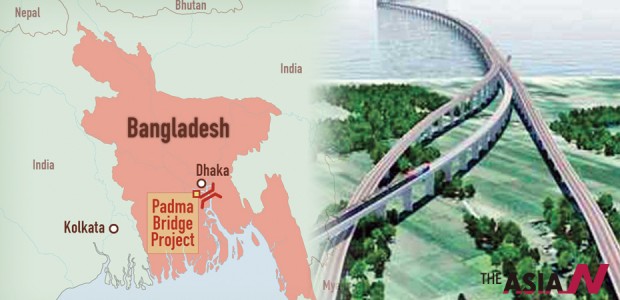Bangladesh to build Padma Bridge with own resources
As the biggest global lender, the World Bank (WB), has backed out from the supporting Bangladesh’s largest infrastructure development project, the Bangladesh government has decided to construct the country’s biggest rail-road bridge over the mighty Padma river with its own resources. The tender for construction of the 6.15 kilometer long bridge will be floated in the last week of June according to the Bangladesh Communication Minister Obaidul Quader.
The ruling coalition government led by the Awami League (AL) has resolved to take up the construction within its remaining tenure after it formally withdrew its request to the WB in January this year.
The AL-led government headed by Prime Minister Sheikh Hasina came to power in January 2009 and is scheduled to complete its tenure in January 2014. The construction of the Padma bridge, a long-standing demand of the people of the country’s south-western region, was an electoral commitment of the AL and Hasina’s government, and was taken up for implementation soon after Hasina came to power. The project plan for the bridge was prepared within a couple of years while the government negotiated with foreign donors for its funding.
The project cost for the Padma bridge was estimated at about US$ 3 billion of which the World Bank (WB) committed to provide US$ 1.2 billion. Among others, Asian Development Bank (ADB) promised US$ 615 million, Japan International Cooperation Agency (JICA) US$ 415 million and Islamic Development Bank (IDB) assured US$ 140 million. The government of Bangladesh is supposed to provide the rest of the cost and has already allocated a big chunk from the country’s Annual Development Program (ADP) fund for the project. The project is scheduled to be implemented within three years.
The two-level steel truss bridge has been designed to carry a four-level highway on the upper level and a single track railway on the lower level. When completed, it will be the longest bridge in Bangladesh and will connect the country’s south-western region with the northern and eastern regions. At present, the people of the south-western region travel to the capital city Dhaka and other regions of the country by crossing the Padma river with ferries or vessels through waterways.
The proposed Padma bridge will not only facilitate movement and transportation, but will have a considerable positive impact on the country’s economy. Economists say the bridge will boost the country’s GDP by one percent a year.
Allegation of Corruption Conspiracy
The Padma bridge has been a dream of the nation for decades. Yet, progress has been slowed down due to conflict between the government of Bangladesh and the WB. In late 2011, the WB raised allegations of corruption conspiracy between the Bangladesh officials concerned such as former Communication Minister Syed Abul Hossain and a former State Minister Abul Hasan Chowdhury and Canada-based construction firm SNC-Lavalin for facilitating the Canadian company to get the contract for the bridge.
The Bangladesh government responded to the WB’s allegation by asking the Anti-Corruption Commission (ACC), a sovereign anti-graft body of the country, to enquire into the matter and also transferred or suspended some senior officials involved with the project. But the government was reluctant to take any action against the former Minister Syed Abul Hossain, who was a member of parliament (MP) belonging to the AL. He, however, was transferred to another ministry and later resigned from the Cabinet.
However, the WB remained unsatisfied about the steps taken by the Bangladesh government and insisted on action against the former Communication Minister Syed Abul Hossain. But the government declined and the WB announced in mid-2012 that it would not provide funds for the Padma bridge project. Other foreign donors including the ADB followed path and pulled out from the project.
Bangladesh Finance Minister AMA Muhith is still optimistic about obtaining foreign funds from sources other than the WB. He said, “There is a strong possibility of ADB and JICA returning to fund the rail-road bridge project although they pulled out of the project due to problems we had with the World Bank. They now appear to be interested to come back.”
The Finance Minister observes that funding will not be a problem for the Padma bridge project since Bangladesh has a foreign exchange reserve of nearly US$ 15 billion of which US$ 1800 million can be drawn.
India has already offered US$ 200 million out of its previously pledged US$ one billion line of credit from 2010 for the Padma bridge project. Besides its own resources, if Bangladesh can obtain loans from other sources like the ADB, JICA and IDB, smooth funding for the project will be fully ensured.
Hasina shoulders big risk?
Since the world’s biggest lender, the World Bank, is no more involved with the funding of Bangladesh’s mega project Padma bridge, the question remains whether this developing country can do the job itself. Economists say Bangladesh can actually afford to undertake such a huge project on its own – something unthinkable even five years ago. Many feel Prime Minister Sheikh Hasina has shouldered a big risk by deciding to go ahead with the Padma bridge project with the country’s own resources. But, many others believe it will be a major achievement for the country if Bangladesh carries it out.
The present government headed by Prime Minister Sheikh Hasina has barely seven months in office before the general elections. Therefore, this government is keen to start the implementation of the Padma bridge project within its tenure. Anyway, whoever comes to power through the next elections will have to build the Padma bridge at any cost, since it is the dream and desire of the whole nation.
































































